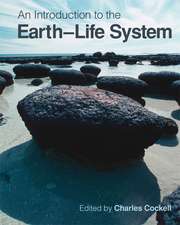Symbiotic Fungi: Principles and Practice: Soil Biology, cartea 18
Editat de Ajit Varma, Amit C. Kharkwalen Limba Engleză Paperback – 14 mar 2012
The protocols offer practical solutions for researchers and students involved in the study of symbiotic microorganisms. The volume will be of great use for basic research, biotechnological applications, and the development of commercial products.
| Toate formatele și edițiile | Preț | Express |
|---|---|---|
| Paperback (1) | 1224.18 lei 6-8 săpt. | |
| Springer Berlin, Heidelberg – 14 mar 2012 | 1224.18 lei 6-8 săpt. | |
| Hardback (1) | 1233.83 lei 6-8 săpt. | |
| Springer Berlin, Heidelberg – 11 sep 2009 | 1233.83 lei 6-8 săpt. |
Din seria Soil Biology
- 18%
 Preț: 958.56 lei
Preț: 958.56 lei - 18%
 Preț: 1225.62 lei
Preț: 1225.62 lei - 18%
 Preț: 957.75 lei
Preț: 957.75 lei - 18%
 Preț: 1232.09 lei
Preț: 1232.09 lei - 18%
 Preț: 949.90 lei
Preț: 949.90 lei - 18%
 Preț: 1392.95 lei
Preț: 1392.95 lei - 18%
 Preț: 952.26 lei
Preț: 952.26 lei - 18%
 Preț: 1231.32 lei
Preț: 1231.32 lei - 18%
 Preț: 956.03 lei
Preț: 956.03 lei - 18%
 Preț: 948.29 lei
Preț: 948.29 lei - 18%
 Preț: 1226.90 lei
Preț: 1226.90 lei - 18%
 Preț: 952.26 lei
Preț: 952.26 lei - 18%
 Preț: 942.63 lei
Preț: 942.63 lei - 18%
 Preț: 946.55 lei
Preț: 946.55 lei - 18%
 Preț: 1221.20 lei
Preț: 1221.20 lei - 18%
 Preț: 1225.94 lei
Preț: 1225.94 lei - 18%
 Preț: 946.24 lei
Preț: 946.24 lei - 24%
 Preț: 1051.27 lei
Preț: 1051.27 lei - 18%
 Preț: 1221.02 lei
Preț: 1221.02 lei - 18%
 Preț: 947.98 lei
Preț: 947.98 lei - 18%
 Preț: 948.47 lei
Preț: 948.47 lei - 18%
 Preț: 1222.31 lei
Preț: 1222.31 lei - 18%
 Preț: 1231.64 lei
Preț: 1231.64 lei - 18%
 Preț: 1225.31 lei
Preț: 1225.31 lei - 18%
 Preț: 1229.73 lei
Preț: 1229.73 lei
Preț: 1224.18 lei
Preț vechi: 1492.91 lei
-18% Nou
Puncte Express: 1836
Preț estimativ în valută:
234.25€ • 245.07$ • 194.59£
234.25€ • 245.07$ • 194.59£
Carte tipărită la comandă
Livrare economică 03-17 aprilie
Preluare comenzi: 021 569.72.76
Specificații
ISBN-13: 9783642260278
ISBN-10: 3642260276
Pagini: 452
Ilustrații: XXI, 430 p. 89 illus., 8 illus. in color.
Dimensiuni: 155 x 235 x 24 mm
Greutate: 0.63 kg
Ediția:2009
Editura: Springer Berlin, Heidelberg
Colecția Springer
Seria Soil Biology
Locul publicării:Berlin, Heidelberg, Germany
ISBN-10: 3642260276
Pagini: 452
Ilustrații: XXI, 430 p. 89 illus., 8 illus. in color.
Dimensiuni: 155 x 235 x 24 mm
Greutate: 0.63 kg
Ediția:2009
Editura: Springer Berlin, Heidelberg
Colecția Springer
Seria Soil Biology
Locul publicării:Berlin, Heidelberg, Germany
Public țintă
ResearchCuprins
Symbiosis: The Art of Living.- Analysis of Rhizosphere Fungal Communities Using rRNA and rDNA.- Use of Mycorrhiza Bioassays in Ecological Studies.- In Vivo Model Systems for Visualisation, Quantification and Experimental Studies of Intact Arbuscular Mycorrhizal Networks.- Measurement of Net Ion Fluxes Using Ion-Selective Microelectrodes at the Surface of Ectomycorrhizal Roots.- Assessment of Phosphatase Activity Associated with Mycorrhizal Fungi by Epi-Fluorescent Microscopy.- In Vitro Compartmented Systems to Study Transport in Arbuscular Mycorrhizal Symbiosis.- Use of the Autofluorescence Properties of AM Fungi for AM Assessment and Handling.- Role of Root Exudates and Rhizosphere Microflora in the Arbuscular Mycorrhizal Fungi-Mediated Biocontrol of Phytophthora nicotianae in Tomato.- Assessing the Mycorrhizal Diversity of Soils and Identification of Fungus Fruiting Bodies and Axenic Cultures.- Isolation of Metabolically Active Arbuscules and Intraradical Hyphae from Mycorrhizal Roots.- Interaction with Soil Microorganisms.- Isolation, Cultivation and In Planta Visualization of Bacterial Endophytes in Hanging Roots of Banyan Tree (Ficus bengalensis).- Micro-PIXE Analysis for Localization and Quantification of Elements in Roots of Mycorrhizal Metal-Tolerant Plants.- Functional Genomic of Arbuscular Mycorrhizal Symbiosis: Why and How Using Proteomics.- Using Stable Carbon Isotope Labelling in Signature Fatty Acids to Track Carbon Allocation in Arbuscular Mycorrhiza.- 15N Enrichment Methods to Quantify Two-Way Nitrogen Transfer Between Plants Linked by Mychorrhizal Networks.- Analyses of Ecophysiological Traits of Tropical Rain Forest Seedlings under Arbuscular Mycorrhization: Implications in Ecological Restoration.- Techniques for Arbuscular Mycorrhiza Inoculum Reduction.- Best Production Practice of Arbuscular Mycorrhizal Inoculum.- The Use of AMF and PGPR Inoculants Singly and Combined to Promote Microplant Establishment, Growth and Health.- Co-Culture of Linum album Cells and Piriformospora indica for Improved Production of Phytopharmaceuticals.- Fungal Elicitors for Enhanced Production of Secondary Metabolites in Plant Cell Suspension Cultures.- Auxin Production by Symbiotic Fungi: Bioassay and HPLC-MS Analysis.- Siderophores of Mycorrhizal Fungi: Detection, Isolation and Identification.- Biology and Molecular Approaches in Genetic Improvement of Cultivated Button Mushroom (Agaricus Bisporus).
Recenzii
From the reviews:
“Symbiotic fungi was published in 2009 and is a compilation of 26 edited chapters on this theme by more than 70 international authors. … If you are interested in the methods for study mycorrhizal fungi this is certainly the book you must have. … should be available in all good school, community and university libraries and any research laboratories dealing with agriculture or mycorrhizal research. A essential book addressing mycorrhizal methods.” (K. D. Hyde, Fungal Diversity, Vol. 45, 2010)
“Symbiotic fungi was published in 2009 and is a compilation of 26 edited chapters on this theme by more than 70 international authors. … If you are interested in the methods for study mycorrhizal fungi this is certainly the book you must have. … should be available in all good school, community and university libraries and any research laboratories dealing with agriculture or mycorrhizal research. A essential book addressing mycorrhizal methods.” (K. D. Hyde, Fungal Diversity, Vol. 45, 2010)
Caracteristici
Includes supplementary material: sn.pub/extras





